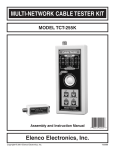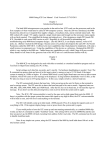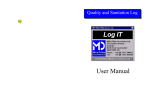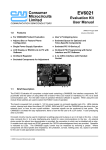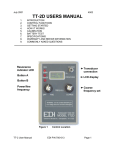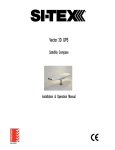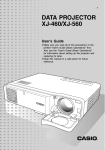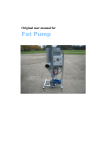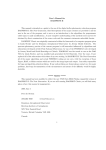Download TT-2Dx User`s Manual-5
Transcript
ELECTRONIC DEVICES INC. P.O. BOX 15037, CHESAPEAKE, VA 23328 • PHONE (757) 421-2968 • FAX (757) 421-0518 TT-2Dx USER'S MANUAL 1. 2. 3. 4. 5. 6. 7. 8. 9. Tuning indicator INTRODUCTION CONTROL FUNCTIONS GETTING STARTED HOW IT WORKS CALIBRATION BATTERY TEST SPECIFICATIONS WARRANTY AND REPAIR INFORMATION COMMONLY ASKED QUESTIONS Transducer Button A Button B Power, fine frequency Coarse frequency set 1 INTRODUCTION The TT-2Dx is designed to test acoustic transducers for resonance over the frequency range of 10 KHz to 2700 KHz. The TT-2Dx tests most all types of transducers, including transformer-coupled and magnetostrictive devices. The transducers relative phase and the impedance at resonance are displayed on the two line LCD display. The leakage resistance of the transducer can be measured and displayed over the range of 40 ohms to 10 megohms. 2 CONTROL FUNCTIONS Refer to the cover picture for the location of the controls discussed in this section. 2.01 TRANSDUCER CONNECTION The XDUCER output connects to the transducer under test. WARNING: Do not connect a depth sounder or any other source of power to this connector. If you do, the TT-2Dx will be seriously damaged. The transducer connection is an output only. 2.02 LCD DISPLAY The impedance is displayed on the upper line, left side. Relative phase (+ or -) is to tthe right. The frequency in KHz is displayed on the lower line. When the power is turned on, model nomenclature, software version and battery voltage are displayed for 3 seconds. 2.03 COARSE FREQUENCY SET KNOB This controls the frequency sent to the transducer from less than 10 KHz to over 2.7 MHz. 2.04 POWER/FINE FREQUENCY SWITCH This knob controls the power and is also used to fine tune the frequency setting. The frequency range is about 10% of that set by the coarse frequency control. 2.05 BUTTON A, OHMS The primary function of this push button switch is to select the ohmmeter mode When this button is pressed, the DC resistance of the transducer is displayed in ohms on the bottom line of the display. The range covers 10 ohms to 10 meg ohms. Press button B once to return to normal operation. 2.5.1 The secondary function of button A increases the display contrast if pressed while the model, software version and battery voltage are displayed just after the power is turned on . 2.06 BUTTON B, RANGE The primary function of this push button switch is to select one of the three frequency ranges. The range increments each time this button is pressed. Each range covers the frequencies shown below: 2.06.01.01 Range 1: 10 KHz to 100 KHz. 2.06.01.02 Range 2: 100 KHz to 1 MHz. 2.06.01.03 Range 3: Extended range up to 2.7 MHz. 2.06.02 The secondary function of button A decreases the display contrast if pressed while the model, software version, and battery voltage are displayed just after the power is turned on. TT-2Dx Page 2 031612 2.06.03 SETTING DEFAULT FREQUENCY RANGE: To select a frequency range as the default range, select the range and before releasing button B, press button A. Release both buttons after the display shows 'FR store' on the bottom line. This range will be selected each time the TT-2Dx is powered-up. 2.07 TUNE INDICATOR The TUNE indicator helps to identify the resonant frequency points when the frequency is tuned up and down. As the frequency approaches the resonant point of the transducer the TUNE indictor will increase in brightness. The brighter the TUNE indicator, the lower the impedance is. This LED will also flash during the self-test routine occurring when the power is turned on.. 3 GETTING STARTED Connect the TT-2Dx XDUCER output to a transducer using the provided test cable. Turn the power on and the TT-2Dx will go through a quick test routine while displaying the battery voltage. While the TT-2Dx is in the self-test mode, the contrast may be changed and stored by pressing buttons A or B. After the test routine finishes, the TT-2Dx will display the frequency on the bottom line. If necessary, select the appropriate frequency range by pressing and releasing button B. Tune for resonant points by slowly rotating the coarse frequency control over it's range while watching the resonance indicator's intensity. There will be several resonant points for most transducers. Choose the one that gives the brightest indication on the LED. Fine tune the frequency with the fine frequency control while watching the upper left part of the display for the lowest Zo indication. The phase indication will usually be near zero when the impedance is at a minimum. 3.01 SORTING OUT MULTIPLE RESONANCE POINTS Most transducers you test will have three major resonance points. A major resonance point has a significant peak in the resonance indicator and a low impedance over a narrow frequency range. The problem is to determine the correct resonant point. This will usually be the frequency where the most power is transferred from the face of the transducer. Check the energy transfer at each resonant point by pressing on the center of the transducer face with a fingertip while observing the impedance displayed on the top line of the LCD. The readings will change noticeably with moderate finger pressure. The resonant point that produces the most pronounced change of impedance is usually, BUT NOT ALWAYS, the correct operating frequency for the transducer. 3.02 MEASURING TRANSDUCER IMPEDANCE The transducer impedance at series resonance is indicated on the upper left of the LCD. The relative phase angle is displayed in the upper right of the LCD. A negative (-) sign indicates the load looks capacitive to the TT-2Dx, and a positive sign (+) indicates the load is inductive. The lowest impedance reading will usually occur when the relative phase angle displayed is close to zero. 3.03 TRANSDUCER DC RESISTANCE Press ad release button A to check the resistance of the transducer. The measurement range is from 10 ohms to 5 megohms. Piezoelectric transducers that are not transformer coupled should indicate '>10M ohm' of leakage after a few seconds. Transformer coupled transducers usually have only a few ohms of resistance, and the LCD will indicate '<40 Ohms'. TT-2Dx Page 3 031612 4 HOW IT WORKS The TT-2Dx sends a signal through a 100 ohm resistor to the transducer under test. The voltage waveform at the transducer is sampled at three specific points per cycle. The relationship of the voltages at the sample points determine the impedance and relative phase of the voltage across the transducer. The impedance (Zo) is calculated and displayed over the range of 1 to 9990 ohms and the relative phase shift is displayed to the right of the impedance reading. A plus (+) sign (voltage leads current) indicates an inductive load, and a minus (-) sign (voltage lags current) indicates a capacitive load. The numbers following the polarity sign range from 0 to 30, with the higher numbers indicating a higher reactance. 5 CALIBRATION Calibration of the TT-2Dx should not be necessary unless repairs have been made, internal parts have been changed, or the readings are suspect. The calibration is done with the output short-circuited. The TT-2Dx is then checked with a 100 ohm and 1000 ohm resistor across the output to see if the displayed readings are within specifications. The equipment required to check the TT-2Dx calibration follows: 5.01.01 Frequency counter with .005% or better accuracy. 5.01.02 100 ohm 5% resistor. 5.01.03 1000 ohm 5% resistor. 5.02 CHECKING SHORT CIRCUIT LOAD CALIBRATION Turn the TT-2Dx on. Check the displayed battery voltage. It must be greater than 6.5 volts. If not, replace the battery. Set the frequency to 50 KHz and short the output by connecting the test cable clip-leads together. The impedance should read between -1 to +1. If the reading is not within this range the unit should be calibrated. For instructions, see 5.05 SHORT CIRCUIT LOAD CALIBRATION procedure. 5.03 CALIBRATION Turn the TT-2Dx on and set the frequency to 50 KHz. Short the clip leads and verify that the reading is within +/- 1 ohm. If the reading is out of spec, try the SHORT CIRCUIT CALIBRATION procedure. 5.03.01 Connect the 100 ohm resistor to the clip leads and verify the displayed reading is 100 +/- 10 ohms. If the reading is not within specifications the unit must be returned to the factory for repair. 5.03.02 Remove the 100 ohm resistor and connect the 1000 ohm resistor. Verify that the displayed reading is 1000 +/- 100 ohms. If the reading is not within specifications the unit must be returned to the factory for repair. 5.04 CHECKING FREQUENCY ACCURACY Set the TT-2Dx as close as possible to 50 KHz. Connect the counter to the XDUCER jack and verify that the displayed reading is within 0.05% (+/- 0.025 kHz at 50 Khz) of that on the frequency counter. If the reading is out of spec the unit must be returned to the factory for repair. TT-2Dx Page 4 031612 5.05 SHORT CIRCUIT LOAD CALIBRATION Turn the coarse frequency control to the maximum CCW position. Turn TT-2Dx off. Connect the clip leads together to short circuit the output. Press and hold both the A and B buttons and then turn on the power. Watch the display and release both buttons immediately after the display flashes 'Cal mode'. If the buttons are not released quickly, the unit will not enter the calibration mode. Wait a few seconds until the display changes to "ADC=xxx" on the top line. The value of xxx should be a stable reading between 500 and 513, if not, the test cable or TT-2Dx may need repairs. Press button B to store the ADC calibration value. Turn the TT-2Dx off then back on. Check to make sure the shortcircuit impedance reads within +/- 1 ohm. If not, check the test lead for continuity and repeat the calibration. If the reading is still out of specification the unit must be returned to the factory for repair. 5.06 OHM METER TEST Turn the TT-2Dx on and press button "A" to put the TT-2Dx into the DC resistance measurement mode. Short the clip leads together and verity that the display reads '<40 Ohms'. Open the clip leads and verify the display reads '>10M ohms'. Place a 10 K resistor across the clip leads and verify the display reading is between 9000 and 11000 ohms. If the readings are out of specification the unit must be returned to the factory for repair. 6 BATTERY TEST The battery should be replaced if the voltage falls below 6.5 volts as indicated on the display when the TT-2Dx is powered-up. 6.01 BATTERY REPLACEMENT The battery compartment is located on the back side of the TT-2Dx. Turn the TT-2Dx face down and remove the battery cover by pressing down and outward with your thumb. The cover will then slide free from the case, exposing the battery. For maximum operating time, use 9V alkaline batteries, not carbon-zinc, when replacing the batteries. 7 SPECIFICATIONS FREQUENCY RANGE: FREQUENCY ACCURACY: FREQUENCY RESOLUTION: IMPEDANCE RANGE: IMPEDANCE ACCURACY: TRANSDUCER TYPES: BATTERY TYPE: CURRENT DRAIN: EST BATTERY LIFE: RECOMMENDED BATTERY: WEIGHT: SHIPPING WEIGHT: TT-2Dx 10 KHz to 2700 KHz. 0.05% of indicated frequency +/- 1digit. 0.01 KHz 5 - 1000 ohm, usable 1 - 9990 ohms. 10% of indicated reading. All types, including transformer coupled. Standard 9V transistor radio type. 25 mA avg, 40 mA max. 10 hours continuous use with alkaline battery. Alkaline type similar to EVER READY #522 or equivalent. 11 ounces with battery and test cable. 2 pounds. Page 5 031612 8 WARRANTY INFORMATION Unit will be repaired free of charge for one year from date of purchase providing there is no water damage or other evidence of improper use or handling. Purchaser must ship unit prepaid to address below; EDI will pay the return freight. Please call before shipping your unit back to us. Phone: 1-757-421-2968 Fax: 1-757-421-0518 For repair, please enclose a note describing the problem and ship to: ATTN: Service Department Electronic Devices, Inc. 3140 Bunch Walnuts Road Chesapeake, VA. 23322 9 COMMONLY ASKED QUESTIONS 9.01 HOW TO SET THE CONTRAST To set the contrast, turn the TT-2Dx off and back on. Press button A or B while the battery voltage is displayed. The contrast setting is stored after releasing both buttons. The impedance and frequency display will return a few seconds after releasing the buttons. 9.02 HOW TO SELECT THE FREQUENCY RANGE To change the frequency range press button B. The selected frequency range will be displayed while the button is held down. When the button is released the TT-2Dx will operate on that range. 9.02.01 If the frequency range is stored it will be selected whenever the TT-2Dx is turned on. To store the range, select it as above, but do not release button B when the desired range is displayed. While holding button B down, momentarily press button A then release both buttons. The display will momentarily read 'FR store' to indicate the frequency range has been stored to memory. 9.03 HOW TO MEASURE LEAKAGE Press and release button A and the display will read 'Ohms chk' on the top line. The resistance will be displayed on the bottom line in exponential format. For example, a 1,200 ohm resistor will read '1.20E+03' on the bottom line of the display. If no leakage is present, the display will read '>10M ohms'. Allow several seconds to elapse for the reading to stabilize. To return to normal operation, press and release button B. 9.04 HOW TO DETERMINE IF A TRANSDUCER IS DEFECTIVE A transducer is defective or the wiring is faulty if no resonant points are observed. All transducers should have an indication of resonance at or near the published operating frequency. 9.04.01 A multi-element transducer with one damaged element may resonate at the correct frequency, but the impedance reading will change by a good amount. If there is any doubt, compare the readings to a known good transducer. When making comparative readings, both transducers must be tested in air or in water. Do not compare the reading in air to the reading in water as there can be a big difference in the measured impedance. TT-2Dx Page 6 031612 9.04.02 If a transducer indicates any measurable leakage (less than 10M ohms), the wiring should be checked. If the wiring is not leaky, the transducer should be replaced even if it still works with the depth sounder. Because of the high pulse voltage used, a leaky transducer will soon break down internally and cease to operate. 9.05 WHAT HAPPENS IF THE TT-2Dx IS CONNECTED TO A DEPTH SOUNDER 9.05.0 If the TT-2Dx is connected to an operating depth sounder it will be damaged. The symptoms are no resonance indication and no change in readings when the output shorted or open, but the frequency readout continues to work. 9.05.02 In most cases this is easily repaired. Open the case by removing the POWER/FINE FREQUENCY knob and the four screws at the bottom. Check D1 and R14 for damage and replace as necessary. These parts are located adjacent to the FINE FREQUENCY potentiometer. Also replace socketed IC's U3 and U10 if the TT-2Dx still does not work. Re-assemble the TT-2Dx and calibrate it before using. 9.05.03 Parts required R14 100 ohm 5% 1/4 watt film resistor. D1 1N4736 1W 6.8V Zener diode U3 74HC4066 U10 74HC4049 Accessories for the TT-2Dx A series of molded adapter cables for the TT-2Dx are now available from Gemeco. These adapters will simplify the job of connecting the TT-2Dx to the most popular Airmar transducers. Part Number Usage EDI-RAY EDI Test Cable For Ray, D&T,DSM Series EDI-9RAYA EDI Test Cable For Ray, D&T, A Series EDI-9BB EDI Test Cable For Sitex, DST, Black Box EDI-8NAV EDI Test Cable For Navman, DST, 8-Pin EDI-7SIM EDI Test Cable For Simrad, DST, 7-Pin EDI-7LOW EDI Test Cable For Lowrance, D&S, 7-Pin EDI-6NAV EDI Test Cable For Navman, D&T, 6-Pin EDI-6GAR EDI Test Cable For Garmin, DST, 6-Pin EDI-10NS EDI Test Cable For NStar, DST, 10-Pin EDI-10FUR EDI Test Cable For Furuno, DST, 10-Pin Please contact sales at www.gemeco.com to order the above adapter cables. TT-2Dx Page 7 031612








